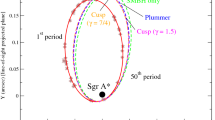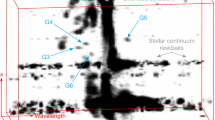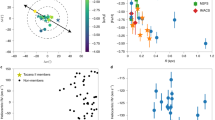Abstract
In addition to their natural satellites, the giant planets possess a surprisingly rich population of moonlets, rings, arcs and diffuse haloes of dust1–6, the dynamics of which involves gravitational interactions7 and radiation and magnetic forces8,9. Recent analyses (by A.B., W. Hubbard, F.R. and B.S.) of isolated events observed around Neptune indicate the existence of an incomplete or at least a highly azimuthally variable ring or ‘arc’ around Neptune. Similar phenomena may be detectable around Uranus. In order to look for yet undetected dark matter around Uranus and Neptune, the best signal-to-noise ratio stellar occultations have been reanalysed. To be confirmed, an ‘event’ should be observed with more than one telescope on the same site since the Fresnel scale (see below) is about 2–3 km at the level of Uranus and Neptune, and it should also be observed from widely separated observatories (100–1,000 km) to have an idea of the spatial extent of the occulting object, and to distinguish between satellites and ring-like structures. Moreover, theoretical models of diffracting bars or circular objects provide useful tests to reject some isolated events as being incompatible with real and celestial events10. We report here an investigation of the surroundings of Uranus and Neptune using stellar occulations observed at the European Southern Observatory (ESO) on 22 April 1982 and at the Canada France Hawaii Telescope (CFHT) on 15 June 1983, respectively. The high signal-to-noise ratio of these observations sets stringent limits on the presence of matter around these planets.
This is a preview of subscription content, access via your institution
Access options
Subscribe to this journal
Receive 51 print issues and online access
$199.00 per year
only $3.90 per issue
Buy this article
- Purchase on Springer Link
- Instant access to full article PDF
Prices may be subject to local taxes which are calculated during checkout
Similar content being viewed by others
References
Owen, T. et al. Nature 281, 442–446 (1979).
Smith, B. A. et al. Science 212, 163–191 (1981).
Elliot, J. L. & Nicholson, P. D. in Planetary Rings (eds Greenberg, R. & Brahic, A.) 25–72 (University of Arizona Press, Tucson, 1984).
Burns, J. A., Showalter, M. R. & Morfill, G. E. in Planetary Rings (eds Greenberg, R. & Brahic, A.) 200–272 (University of Arizona Press, Tucson, 1984).
Showalter, M., Burns, J. & Cuzzi, J. Nature 316, 526 (1985).
Brahic, A. et al. Nature (Submitted).
Goldreich, P. & Tremaine, S. A. Rev. Astr. Astrophys. 20, 249–283 (1982).
Mignard, F., in Planetary Rings (eds Greenberg, R. & Brahic, A.) 333–366 (University of Arizona, Tucson, 1984).
Burns, J. A., in Formation des Systèmes Planétaires (ed Brahic, A. ) 472–442 (Centre National d'Etudes Spatiales, Cépadues Editions, Toulouse, 1982).
Roques, F., Moncuquet, M., Sicardy, B. & Brahic, A. Astron. J. (in the press).
Klemola, A. R., Mink, D. J. & Elliot, J. L. Astr. J. 86, 138–140 (1981).
Mink, D. J., Klemola, A. R. & Elliot, J. L. Astr. J. 86, 135–137 (1981).
Matthews, K., Neugebauer, G. & Nicholson, P. D. Icarus 52, 126–135 (1982).
Elliot, J. L., French, R. G., Meech, K. J. & Elias, J. H. Astr. J. 89, 1587–1603 (1984).
Sicardy, B. et al. in Les Anneaux des Planètes Proc. IAU Colloq. No. 75, 181–191 (1984).
Hubbard, W. B. Science 231, 1276–1278 (1986).
Cooke, M. L., Nicholson, P. D., Matthews, K. & Elias, J. H. Bull. Am. astr. Soc. 17, 719 (1985).
Sicardy, B. et al. Bull. Am. astr. Soc. 17, 923 (1985).
Reitsema, H. J., Hubbard, W. B., Lebofsky, L. A. & Tholen, D. J. Science 215, 289–291 (1981).
Sicardy, B. et al. Bull. Am. astr. Soc. 15, 816 (1983).
Hubbard, W. B. et al. Nature 319, 636–640 (1986).
Maddox, J. Nature 318, 505 (1985).
Author information
Authors and Affiliations
Rights and permissions
About this article
Cite this article
Sicardy, B., Roques, F., Brahic, A. et al. More dark matter around Uranus and Neptune?. Nature 320, 729–731 (1986). https://doi.org/10.1038/320729a0
Received:
Accepted:
Issue Date:
DOI: https://doi.org/10.1038/320729a0
Comments
By submitting a comment you agree to abide by our Terms and Community Guidelines. If you find something abusive or that does not comply with our terms or guidelines please flag it as inappropriate.



